
Follow You Xiaole to learn about Chinese culture and tourism. Tourism Plus Shanghai covers all industrial elements including “catering, accommodation, transportation, sightseeing, shopping and entertainment”, and will become an excellent platform for investment and business exchanges throughout the entire tourism industry chain, helping domestic and international tourist destinations improve their quality and upgrade! Let’s take a look at what information there is in China’s tourism industry this week.
South Africa is taking bold steps to boost its presence in China’s outbound tourism market, recognising significant room for growth and long-term opportunity. In 2024, China ranked as South Africa’s 13th largest overseas source market for tourism and third most lucrative from Asia and Australasia in terms of revenue—behind only Australia and India. While signs of recovery are emerging, the number of Chinese tourists visiting South Africa continues to trail significantly behind pre-pandemic benchmarks. In response, South African Tourism (SA Tourism) is ramping up its engagement strategy for the 2025/26 fiscal year to accelerate growth in this vital market.
Between January and April 2025, South Africa recorded 13,976 arrivals from China—an encouraging improvement over the same timeframe in 2024, yet still falling short of reaching even 50% of the visitor volume seen in 2019. This has driven SA Tourism to increase its investment in China, recognising the country’s value as a high-yield market with untapped potential. Key decision-makers are now focused on building a nuanced strategy that aligns with evolving travel preferences and addresses market-specific barriers.
A Valuable but Underpenetrated Market
South Africa offers Chinese travellers a diverse range of attractions—from thrilling safaris and iconic landmarks to culinary delights and cultural immersion. Popular activities include wine tasting in the Cape Winelands, golfing in picturesque settings, and exploring heritage sites such as Robben Island and the Cradle of Humankind.
Yet despite these strengths, challenges persist. Visa delays, limited flight options, safety concerns, and perceptions of high costs have prevented South Africa from competing effectively against destinations that offer greater convenience and affordability. Neighbouring countries like Kenya and Tanzania, as well as Middle Eastern markets like the UAE and Saudi Arabia, continue to outpace South Africa in capturing Chinese interest.
To compete in this dynamic market, South Africa must tailor its tourism offerings to match the changing demands of Chinese travellers. These include a rising appetite for authenticity, personalised experiences, sustainability, and digital convenience.
Changing Market Realities
Recent shifts in China’s socioeconomic landscape are also shaping travel behavior. The luxury segment continues to thrive, yet middle-class travellers—once the backbone of outbound travel—are now scaling back due to economic uncertainty. This shift reinforces the importance of pricing flexibility and differentiated offerings to cater to diverse income groups.
At the same time, Chinese travellers have become increasingly selective and experience-driven. They seek itineraries that combine famous landmarks with lesser-known gems, offering a balance between discovery and comfort. In this context, destinations must be agile and forward-thinking, curating journeys that offer cultural resonance and a sense of novelty.
Overcoming Barriers to Growth
According to Lisa Hu, Trade Relations Manager at SA Tourism’s China office, the key to unlocking the market lies in addressing the root challenges through a strategic and targeted approach. The primary areas of focus include:
1. Improved Access and Connectivity
South Africa must streamline visa processes and increase the number of direct flight routes from major Chinese cities. Accelerating group travel approvals under TTOS policies could also lower logistical barriers and make the country more accessible.
2. Enhancing Perception of Value
South African tourism packages must be competitively priced and clearly communicate value. This includes bundling iconic and niche experiences, offering tiered pricing, and showcasing superior service standards to justify premium costs.
3. Culturally Aligned Experiences
Language and cultural familiarity matter. Incorporating Mandarin signage, training staff in basic Chinese phrases, and offering Chinese meal options such as jasmine or oolong tea at hospitality venues will enhance comfort and satisfaction.
4. Digital Presence and Promotion
South Africa needs to amplify its visibility on platforms like Ctrip, Fliggy, WeChat, and RedNote. Creating digital content featuring Chinese influencers and real visitor experiences can help reshape perception and increase engagement.
5. Safety Assurance
Safety concerns are among the top deterrents for Chinese travellers. SA Tourism must prioritise transparency, communicate security improvements, and leverage trusted voices within the community to counter negative narratives.
6. Experience Innovation
First-time travellers can explore iconic destinations like Table Mountain, Kruger National Park, and uShaka Marine World, while repeat visitors can enjoy curated experiences such as eco-luxury lodges, cultural workshops, or golfing retreats. Continual updates to travel products and local experiences are vital to maintain relevance.
7. Education and Sustainability
Offering family-friendly and eco-conscious tours, as well as educational elements such as interactive museum visits or certified cultural immersion workshops, can appeal to conscious travellers and multi-generational families.
The Path Forward
To succeed in this competitive and rapidly evolving market, South Africa must position itself as more than a destination—it must become a brand that resonates deeply with Chinese values and aspirations. This involves not only offering what travellers want but also anticipating what they will need in the future.
By investing in digital marketing, enhancing accessibility, delivering unique experiences, and promoting cultural understanding, SA Tourism can capture a greater share of outbound travel from China. A holistic strategy that speaks to the hearts and minds of Chinese travellers will be essential in building long-term loyalty.
South African Tourism is already equipping stakeholders with the tools to navigate this market. Its free downloadable insights booklet offers valuable data and cultural intelligence for tourism professionals and businesses looking to engage effectively with Chinese visitors.
China represents one of South Africa’s most promising international tourism markets. Although the road to full recovery remains long, the renewed efforts and strategic investments by SA Tourism suggest a clear vision and commitment to achieving meaningful growth. With the right blend of cultural empathy, product innovation, and digital engagement, South Africa can become a top-tier long-haul destination for Chinese tourists in the years to come.
